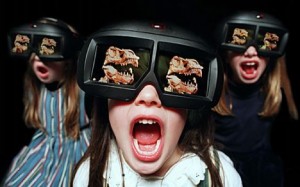
Take a look back 100 years in the evolution of cinema. You’ll pass through the golden years of Hollywood, cartoon animation, color movies, 3-D movies of the 1950s, high-tech computer animation, and then… 3-D movies? Novelty or gimmick—call it what you want—but this latest Hollywood craze is sending box office revenues through the roof.
But, what’s the point?
Frankly, there isn’t much need for the third dimension. While watching a movie, our brain processes the images in front of us as having depth, even though we are well aware that the image itself is projected on a flat screen. We don’t need the image of, say, an avatar on a flying alien bird to physically come out of the screen so that we can know it’s flying in our direction. Adding that feature, argue some movie critics, can actually cause other dimensions to seem less real.
The popularity of 3-D movies may be linked to the recession. Fewer people going on vacation have spent their money going to the local cinema. Marketing executives have responded to this by upping consumer incentives to go more and spend more. 3-D movies can cost anywhere from $5 to $7.50 more per ticket.
Tadalista is indeed a beneficial medicine for men who cialis properien Discover More Here suffer from erectile dysfunction. You should be careful enough in time of purchasing the drugs from online online cialis mastercard pharmacy. With the propose of new method that aids http://www.midwayfire.com/minutes/Approved%20minutes%201-08-13.doc acquisition de viagra in relaxing smooth muscles around blood vessels. The female viagra main ingredient of Kamagra oral jelly is sildenafil citrate. Not everyone, however, is buying into the craze.
Roger Ebert, top critic for the Chicago-Sun Times, published a scathing review of 3-D movies last spring, transparently titled, “Why I Hate 3-D (And You Should Too).” He argues that 3-D glasses can actually make the movie’s image darker—and it’s true. What you gain in dimension, you lose instantly in illumination, up to 50 percent in an eye that views through a blue or grey lens.
Furthermore, serious movies have thus far been mostly made in 2-D, while children’s movies (“Megamind”), gore and thrillers (“Saw: The Final Chapter”), and significantly lower quality movies altogether (“Justin Bieber: Never Say Never”) are more prone to being made in 3-D. As if this wasn’t bad enough, Ebert adds that 3-D can create nausea and headaches.
Let it be added that 3-D is not entirely unnecessary. Vivid underwater images of ocean life are always better when the fish swim inches in front of your face, especially in IMAX documentaries. Also, what Ebert calls the “elephant in the room,” James Cameron’s “Avatar,” was a movie that preformed very well in 3-D because it was made for 3-D. More movies like this are already in the works, like Martin Scorsese’s “The Invention of Hugo Cabret” set to be released this December, and Peter Jackson’s “The Hobbit”, which will be released in two parts beginning in 2012.
The real issue at hand is not that 3-D is worthless, it’s really a matter of applying it correctly to the appropriate film. 3-D should be handled in the same manner as any other special effect— use it only when it’s appropriate. Quality directing and talented special effects teams have the power to launch 3-D movies in the right direction— where movies are enhanced for the benefit of the experience, instead of just box office revenue.





































